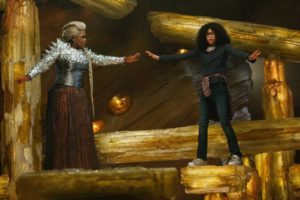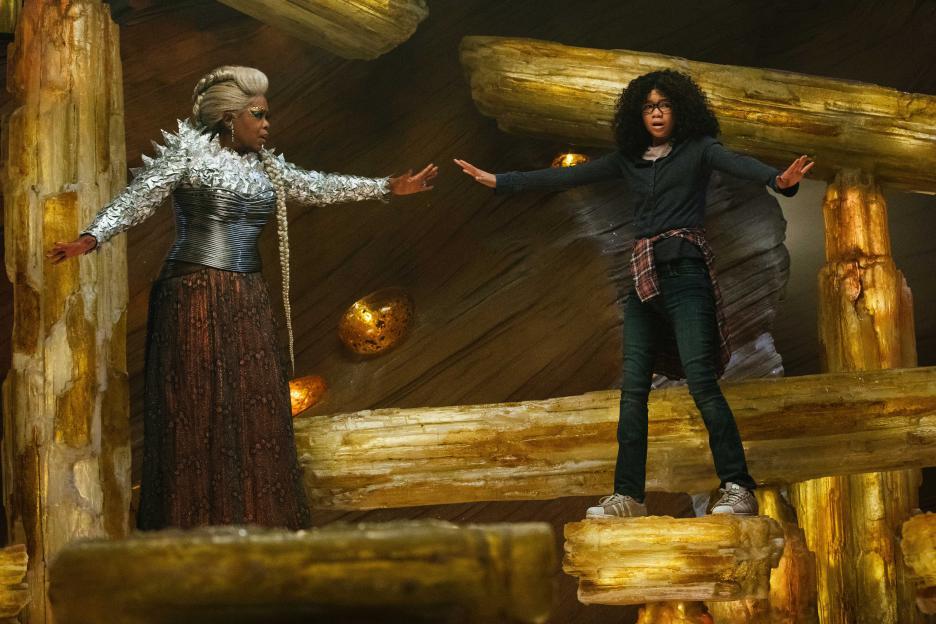Movie Info
Movie Info
- Director
- Ava DuVernay
- Run Time
- 1 hour and 49 minutes
- Rating
- PG-13
VP Content Ratings
- Violence
- 2/10
- Language
- 0/10
- Star Rating
Rated PG-13. Running time: 1 hour 49 min.
Our contents ratings (1-10): Violence 2; Language 0; Nudity/Sex 1.
Our star rating (1-5): 3
You shall not take vengeance or bear a grudge against any of your people,
but you shall love your neighbor as yourself: I am the Lord.
Leviticus 19:18
This is my commandment, that you love one another as I have loved you.
John 15:12

Although it is fitting that Madeleine L’Engle’s spiritually themed classic is directed by a woman who has made her mark in Hollywood (see Selma and 13th), the new film that Ava DuVernay directs is less than I had expected, given its source, a controversial but beloved children’s classic. The quest of a bullied girl grieving over the loss of her father, the film jumps from episode to episode too quickly, with the music often overwhelming the dialogue—at least for me. It has been several decades since I have read the book, a favorite of one of my daughters, so my faded memory of the book’s plot was of little help in understanding what was transpiring on the huge screen. Despite my own confusion, however, I noticed that the attention of most (but not all) of the many children at the preview was rivetted on the giant screen.
Before airing my frustration and dealing with some of the plot, I do want to state that I agree with those praising the film—first for the studio entrusting such a costly production to a woman, a black woman at that. And second, that the script by Jennifer Lee and John Stockwell gamely tries to adapt the story to our time—Mr. & Mrs. Murry are an inter-racial couple (he is white, and she is African American), so daughter Meg is biracial, and they have adopted an orphan, who was about a year old when the scientists disappeared. Thus, it is good to see a biracial girl heroine who is not a super hero save the day while a handsome would-be boyfriend is the second banana. But this still does not add up to a satisfyingly coherent film.
It has been four years since Meg Murry (Storm Reid) and her little adopted brother Charles Wallace’s (Deric McCabe) father Dr. Alex Murry (Chris Pine) disappeared into the void. A brilliant astrophysicist, Dr. Murry had decided to test his Quantum Tesseract Theorem, postulating that one could transverse the universe through “wrinkles in time” connecting planets separated by vast distances of light years. He called this process “tessering.” Their mother (Gugu M-batha Raw), a physicist herself, tries to keep the family’s hopes alive during the long period of his absence. It is on the fifth anniversary of his disappearance (which to the children is an Abandonment) that school bullies taunt Meg, prompting her to hurl a ball at the ring leader’s nose, a rebellious act that lands her in the principal’s office. Sadly, this is not the first such visit.
Charles lets into the house a strange astral being, Mrs. Whatsit, who tells the astonished family that Dr. Murry is still alive and that the children can free him. Soon both brother and sister are conversing with three mysterious beings—all garbed in bizarre, awful looking costumes, Mrs. Whatsit (Reese Witherspoon), Mrs. Who (Mindy Kaling), and Mrs. Which (Oprah Winfrey). Joined by the one classmate who supports her, Calvin O’Keefe (Levi Miller), the three children embark by “tessering” on a quest to find Dr. Murry, one that will land them in all sorts of danger. Meg is wracked often by doubts, so Mrs. Which continually reassures her, telling her that she can do some difficult task set before her–“You can do this!” and “You are a warrior!”
After a series of CGI-enhanced adventures on two planets, the seekers land on the planet Camazotz. By now the three celestial beings have left them, apparently their reason being that Meg has to finish the journey relying on herself, and not outside help.
The planet is in the thrall of an evil force called It or “The Black Thing,” which seeks to bring darkness to the whole universe. All the in habitants are under its control like automatons. This condition is shown in the creepy sequence set in a modern suburban development where every house looks alike—older viewers might be reminded of the old anti-conformist song, “Little Boxes.” A child comes out from each home bouncing a large ball in perfect unison with everyone else, the booming sound almost shaking the screen. The scene then switches to a crowded sea side where all the beach umbrellas look alike.
It is on Camazotz that Dr. Murray is imprisoned, and it is here too where Charles Wallace falls under the control of It. The boy spews out powerful hatred. During this daunting struggle the uncertain Meg finds her inner strength and calls upon the power of love to save the day.
I need to see the film again, perhaps with one of those text-based hearing aids because the loud, intrusive music drowned out so much of the dialogue. I am almost certain that the book’s invocation of the apostle Paul’s “the foolishness of God” (in 1st Cor. 1) was not included, though I do recall a touch of theology was included in Dr. Murray’s dialogue, “What if we are here for a reason. What if we are part of something truly divine?” Best of all, the power of love in overcoming the power of evil is at the center of Meg’s bringing her little brother back from under the power of It. This is a theme that runs throughout the teachings of Jesus and of the apostle Paul, as well as in such portions of the Hebrew Scriptures as Isaiah 52-53, some of the laws in Leviticus, and Proverbs 25.
If you have read thus far, you can perhaps understand my ambivalent feelings about the film—and thus my hesitation about recommending that you either “save your money and read the book,” or go see it for yourself. The film is neither as bad as some critics say (one on YouTube called it “dogs—t”!) nor as good as other state. I can understand how some conservative Christians would regard it as an expression of New Age religion, thanks to the ambiguous nature of the three astral females and their bland advice–“You can do this!” and “You are a warrior!”–which have been stripped of the novel’s explicitely Christian content. I doubt that this film will become another cinema classic like the Wizard of Oz, but for those who want a film that resembles Madelaine L’Engle’s beloved novel (happily combining a love of science and religion, regarding them as compatible and not at odds with each other) this will do. Just don’t expect the same thrill and stimulation of imagination as when you read the book.
This review with a set of discussion questions will be in the March issue of Visual Parables.


The movie is rated PG, not “R” as this post has at the top.
Thanks, Amy, for bringing this to my attention!